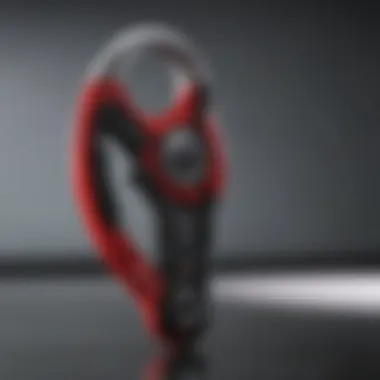Top Rated Wire Strippers: A Complete Guide


Intro
In today’s world, the home improvement industry has seen a surge in DIY projects, driven largely by homeowners who are eager to tackle tasks themselves. Among the many tools available, wire strippers play a vital role in not just electrical repair but also in crafting and various electronic installations. These devices are commonly used to remove insulation from electrical wires, allowing for secure connections. While it might seem straightforward, choosing the right wire stripper can significantly influence the success of any electrical task.
Understanding wire strippers goes beyond simply knowing what they do. It's essential to realize how important they are in ensuring safety and efficiency during electrical work. The right tool can prevent potential accidents and enhance the quality of the job. By grasping the various models available and recognizing their features, homeowners and professionals alike can make informed decisions and save both time and money.
Common Challenges and Solutions
When it comes to wire stripping, homeowners often face several challenges that can hinder their project progress. These issues may include:
- Selecting the wrong tool: Many are overwhelmed by the variety of strippers available. Some may opt for a simple manual version when a more complex automatic stripper would serve them better.
- Improper use: Even experienced hands can make mistakes. Incorrectly stripping a wire can lead to frayed ends, which is a disaster waiting to happen.
- Safety concerns: Working with electricity is dangerous. Not having the right tool might increase the risk of injury or damage.
To overcome these challenges, here are a few tips:
- Research: Take some time to read about different types of wire strippers and what’s best for your specific needs.
- Practice makes perfect: Before starting your main project, practice using the wire stripper on scrap wire to get familiar with the tool.
- Prioritize safety: Always wear appropriate protective gear, and make sure the power is off before starting any work.
Product Recommendations
When it comes to wire strippers, certain brands stand out in the market for their quality and performance. Here are some top recommendations:
- Klein Tools 11055: Known for its durability and ease of use, Klein Tools has a reputation for high-quality products. Their wire stripper provides precise cutting and stripping for both insulated and non-insulated wire.
- Irwin Vise-Grip 2078309: This model is favored for its versatility, handling both light and heavy-duty tasks. It features an adjustable stop for precise length control and is great for different wire gauges.
- Greenlee 45500: For those who prefer automatic wire strippers, the Greenlee model is electric and excels in efficiency, especially for larger wiring projects. Its ergonomic design makes it comfortable to use over long periods.
Each of these options has unique benefits that cater to various applications, from the novice DIYer to seasoned professionals.
Step-by-Step Guides
To strip wire successfully, follow these practical steps:
- Gather your tools: Make sure you have your wire strippers, wire, and any necessary safety gear before starting.
- Select the correct gauge: Check the wire gauge that you’ll be working with. Most strippers have markings that help you choose the right size.
- Measure the length: Decide how much insulation needs to be removed. A common recommendation is to strip around half an inch.
- Position the wire: Insert the wire into the designated slot on the stripper.
- Strip the insulation: Squeeze the handles together firmly, then pull the wire away from the tool while keeping the handles pressed.
- Inspect your work: Make sure the wire is cleanly stripped and there are no rips or frays.
With these steps, you’ll ensure that your wires are ready for any electrical connections you plan to make, ultimately leading to successful and safe projects.
Understanding Wire Strippers
Wire strippers are essential tools in both professional and DIY electrical work. Understanding their purpose and functionality can aid in making informed decisions when it comes to selecting the right type for your needs. By diving deeper into what wire strippers are and how they operate, you'll uncover not just a tool, but a vital assistance in ensuring safe and effective electrical connections.
Definition and Functionality
At its core, a wire stripper is designed to remove insulation from electrical wires. Its functionality goes beyond simply stripping wires; it ensures that connections can be made without damaging the metal conductor beneath.
When using a wire stripper, you insert the wire into the designated slot corresponding to its gauge, squeeze the handles, and the tool successfully strips away the insulation with precision. This is crucial in avoiding accidental shorts and ensuring that electrical connections are up to standard. The right tool prevents mishaps, making the electrical work cleaner and safer for the user.
Types of Wire Strippers
There are various types of wire strippers available, each serving a different purpose and catering to diverse user preferences. Understanding these can significantly influence your purchasing decision.
Manual Wire Strippers
Manual wire strippers are often favored for their simplicity and hands-on usability. They come with different notches to accommodate various wire gauges. A key characteristic of manual strippers is the direct control they afford their users, making them ideal for intricate tasks that require careful handling.
Among their benefits, manual wire strippers enable the user to feel the resistance as they strip the wire, ensuring precision. However, they can be physically taxing when dealing with larger volumes of wire, potentially leading to repetitive strain. Utilizing these tools may take a bit more time compared to their automatic counterparts, but the accuracy often justifies the effort.
Automatic Wire Strippers
Automatic wire strippers are designed for efficiency. These strippers adapt to different wire gauges automatically, allowing for faster processing. A primary aspect of automatic wire strippers is their Spring-loaded design that pulls the trigger after placing the wire inside. This simple mechanism can save time for someone working on larger projects.
However, one major drawback is their dependency on mechanical components, which can wear down over time, causing maintenance issues. Despite this, the speed and ease of operation make them a popular choice among electricians who handle significant quantities of wire regularly.
Electric Wire Strippers
Electric wire strippers are the top tier in speed and efficiency, favored for industrial and large-scale applications. They streamline the process with electric power, stripping multiple wires rapidly without manual effort. A distinguishing feature of electric models is their consistency and precise stripping length adjustment.
Despite their advantages, they may come with a hefty price tag and require a power source, limiting their use in portable applications. Yet, if high-volume work is your game, the initial investment might be worth every penny.
"Choosing the right wire stripper is akin to selecting the right brush for an artist; the wrong choice can lead to a messy job."
Features to Consider
When selecting a wire stripper, it’s crucial to really think about the features that can make a difference between a good tool and a great one. The right features can not only elevate the convenience of your task but also ensure safety and efficiency. This section dives deep into the core elements that stand out when choosing the appropriate wire stripper.
Cutting Capacity
Cutting capacity refers to the maximum wire gauge a stripper can handle. This aspect is pivotal for achieving effortless results. If a tool struggles with thicker gauges, it can lead to uneven cuts or, worse, damage both the wire and the tool. It’s somewhat like trying to fit a square peg into a round hole; it just won’t work out smoothly. Always verify the range of wire sizes the stripper accommodates. A versatile stripper that can handle various gauges, from fine 22 AWG to bulkier 10 AWG, can make life much easier.
Material and Build Quality
The material and build quality of wire strippers should not be underestimated. Tools made from robust materials, like high-carbon steel, last longer and withstand quite a bit of punishment. In terms of design, ergonomic features can often make the difference when you are working on multiple projects consecutively. If you’re using something that feels flimsy or doesn’t have a solid grip, it’s bound to become a hassle pretty quickly. Reliable brands often publish the materials used, which can provide insight into the strength and durability of the strippers.


Comfort and Ergonomics
Comfort and ergonomics can be relatively subjective, but ensuring that your wire stripper feels good in your hand is essential. An uncomfortable handle can lead to fatigue, especially if you’re working on intricate wiring jobs. Look for strippers that offer rubberized grips or padded handles. These features minimize strain and allow for longer usage without discomfort. Moreover, if the stripper has an easy-to-use mechanism — whether manual or automatic — that’s an added bonus. You wouldn’t want to feel like you’re lifting weights while trying to simply strip some wires!
Safety Features
Last but certainly not least, safety features in wire strippers can’t be overlooked. It’s about giving you peace of mind while you work with potentially dangerous tools. Models that include lock mechanisms or grips designed to prevent slipping can drastically reduce the chances of accidents. Additionally, some strippers come with built-in sensors that ensure you're not cutting live wires, a feature some might find extremely valuable. You know the old saying: better safe than sorry. Having tools that contribute to your overall safety is worth every penny you invest.
"Investing in quality tools is a decision to use them with confidence, day in and day out."
In exploring these features, one gains a fuller perspective on how to not only select a wire stripper that fits their needs but also improve their overall experience with wiring tasks. Keeping these considerations in mind can lead to better performance and a more enjoyable project completion.
Top Rated Manual Wire Strippers
Manual wire strippers are essential tools that provide effective means to strip insulation from electric wires without causing damage to the wire itself. Understanding their key features can help homeowners and DIY enthusiasts make informed choices. With a focus on precision and control, these tools are particularly important for small tasks or delicate wiring jobs.
They offer significant benefits such as affordability, ease of use, and simple maintenance. Since they rely on manual force, they give the user full control over the stripping process, which is especially handy for intricate wiring. Importantly, they don’t need a power source, which makes them portable and convenient for various settings, from home projects to professional settings.
Model A: Detailed Review
Specifications
Model A is crafted with high-carbon steel blades that promise durability and longevity. The stripping gauge supports various wire gauge sizes, which is a standout feature. This adaptability ensures that it can be used on a wide range of electrical jobs, making it a versatile choice among manual wire strippers. Additionally, the comfort grip handles are designed to reduce hand fatigue, allowing prolonged use without discomfort.
One unique feature is the integrated wire cutter, which is beneficial for cutting wires cleanly, saving users the step of switching between tools. This blends functionality seamlessly into a single tool.
Pros and Cons
One striking advantage of Model A is its affordability. Compared to automatic or electric wire strippers, this manual option comes with a lower price tag. It’s regarded as a reliable choice for casual or occasional users, making it popular among homeowners and hobbyists.
However, it does have its downsides. The manual operation requires a bit of effort, which may not be ideal for more significant jobs or users who demand faster results.
User Feedback
User feedback on Model A is generally positive, with many praising its ease of use and effectiveness for small jobs. Comments often highlight the sturdy construction, ensuring that it can withstand regular use without issues.
Yet, some users did note that for extensive wire stripping tasks, they found themselves wishing for an automatic version. This is an insight worth considering, especially for those who need to tackle larger projects regularly.
Model B: Detailed Review
Specifications
Model B is distinguished by its precision stripping feature, tailored to efficiently handle finer wires. Users appreciate the adjustable stop settings that allow for customized wire lengths, ensuring a neat stripping job every time.
Its lightweight aluminum frame makes it easy to handle, and that’s indeed a strong point for long projects where hand fatigue could become an issue. Moreover, it has a built-in measurement guide, which adds a layer of convenience for those who might struggle with consistent wire stripping lengths.
Pros and Cons
The primary advantage of Model B lies in its precision. The adjustable stop and measurement guide facilitate a professional finish, appealing to more serious DIYers looking for fine results. This model is perfect for electrical work demanding exactness such as in car wiring and small appliance repairs.
Nevertheless, an important drawback is that it may require users to practice a little before they get the hang of using the adjustable stop feature, which adds a small learning curve.
User Feedback
Users of Model B have mentioned its effectiveness in various projects, especially those that involve intricate wiring. It garners praise particularly for the measurement guide that prevents errors in wire lengths.
Conversely, feedback indicates that beginners may find it a bit challenging to use at first. Such insights offer a window into the model’s learning curve, reminding potential buyers to consider their experience level when choosing the right wire stripper.
Top Rated Automatic Wire Strippers
When it comes to wire stripping, automatic wire strippers can make a world of difference, especially for individuals managing larger projects or seeking efficiency. These tools, designed to strip wires swiftly and with precision, save time and reduce weariness when compared to manual efforts. Given the growing demand for efficiency in both professional environments and daily tasks, understanding the strengths and considerations of top-rated automatic wire strippers is crucial.
Model C: Detailed Review
Specifications
Model C stands out due to its innovative design and user-friendly features. This automatic wire stripper can handle a variety of wire gauges ranging from 10 to 24 AWG, which makes it quite versatile. One key characteristic of Model C is its adjustable stripping depth, allowing users to set the tool perfectly for their specific wire size without unnecessary damage to the wire itself. This feature is notably beneficial because it caters to various tasks—whether you're doing electrical work at home or tackling more complex projects in a workshop.
A unique feature of Model C is its built-in gauge measurement system that eases the stripping process, enhancing accuracy and saving time. While this adds to the tool’s overall efficiency, it might be a bit overwhelming for beginners who are still getting accustomed to working with an automatic tool.
Pros and Cons
The pros of Model C include its speed and efficiency; wire stripping is completed in a fraction of the time it would take with manual tools. Its ergonomic handle makes it easy to grip and minimizes hand fatigue during extended use. On the downside, some users have noted that the automatic mechanisms can occasionally malfunction, particularly under heavy use or with thinner wires. This can lead to some frustration during critical tasks.
In terms of overall performance, the combination of its ease of use and reliability makes Model C a popular choice among both experienced electricians and DIY enthusiasts alike.
User Feedback
Feedback from users of Model C illustrates a common appreciation for its performance. Many highlight how it significantly reduces effort and speeds up their work process. "It feels like I’m cheating when I use it, it’s that fast," says one review. However, on the flip side, some users express concerns regarding the learning curve associated with its automatic functions.


In particular, those who are more accustomed to traditional wire strippers might find it takes a bit of practice to perfect their technique with Model C. Overall, the feedback indicates a satisfactory level of user experience, especially for those willing to adapt to this reliable but slightly complex tool.
Model D: Detailed Review
Specifications
Moving on to Model D, it emphasizes robustness and functionality. This model is well-regarded for its ability to strip multi-strand and solid wires, accommodating sizes between 12 and 26 AWG. One distinct characteristic of Model D is the integrated wire cutter, which allows for multitasking—users can strip and cut wires with one tool, cutting down extra steps.
The design of Model D incorporates a quick-release mechanism, which makes switching between types of wire seamless. Considering the importance of efficiency for both regular DIY projects and professional installations, this feature proves particularly advantageous. However, while the dual-purpose function is appealing, it may lead to wear and tear faster than dedicated tools.
Pros and Cons
The advantages of Model D lie in its durability and versatility. Many users appreciate how sturdy this model feels in hand, suggesting it can withstand demanding work environments. Nevertheless, the weight of the tool is noted as a downside by some, citing that it could become cumbersome, particularly during protracted use.
Thus, when choosing an automatic wire stripper, one must keep in mind that heavier tools might lead to fatigue, while lighter models may sacrifice durability.
User Feedback
User feedback for Model D reveals a positive response regarding its dual functionality. Customers frequently commend its ruggedness and reliability. "I love that I can cut and strip without putting down my tool!" is a sentiment echoed across various reviews. That being said, a few users have reflected on the heft of the device as a potential drawback, especially during lengthy projects, stating that "it gets a might sore on the wrist after a while."
In summary, Model D offers solid performance with its multi-tasking abilities, appealing largely to users who engage in extensive wiring tasks and appreciate a reliable and sturdy tool.
Top Rated Electric Wire Strippers
Electric wire strippers play a vital role in the toolkit of anyone dealing with electrical wiring, whether they be seasoned electricians or enthusiastic homeowners. Their importance cannot be overstated, as they provide a level of efficiency and safety that manual stripping simply cannot match. This section will delve into why electric wire strippers stand out among their peers and what makes them a must-have for a range of applications.
One significant element to highlight is their speed. Electric wire strippers can strip insulation off wires far quicker than manual or even automatic models, which can translate into hours saved during larger projects. This feature is particularly beneficial for tasks where precision and time are essential, like installing electrical outlets or home automation systems. Moreover, many models come with adjustable settings for different wire gauges, allowing users to work on various projects with ease.
In terms of benefits, the ergonomic design of many electric strippers helps reduce strain on the hands during prolonged use. Those who may have struggled with repetitive motion injuries will benefit from this design, which allows for comfortable operation. Additionally, electric wire strippers often include built-in safety mechanisms that prevent accidents by ensuring proper wire placement before cutting, further enhancing user protection.
Model E: Detailed Review
Specifications
When it comes to electric wire strippers, Model E stands out due to its advanced cutting technology. It boasts a built-in microprocessor that detects the wire's gauge and automatically adjusts the stripping length. This precision ensures that no wire is wasted and that the job is done right the first time. Such specifications make it a popular choice for both amateurs and professionals alike because it takes the guesswork out of wiring tasks.
A unique feature of Model E is its dual functionality; it doesn't just strip wires but can also crimp terminals. This versatility is a game-changer for many users, allowing them to complete multiple tasks without switching tools constantly. The downside, however, could be its higher price point compared to simpler models, but many find the blend of features and performance justifies the investment.
Pros and Cons
Looking at the pros and cons of Model E, one must note its efficient design and user-friendly interface as significant advantages. The electric operation allows the user to focus on the task without worrying about hand fatigue typical with manual tools. Users have praised this model for its reliability, reporting consistent performance across varied tasks.
However, on the flip side, some users have mentioned a learning curve associated with the tool, particularly for those who have always relied on manual strippers. One more downside can be its dependence on battery charge or outlet availability, which could limit its use at times. Thus, while Model E tends to excel, understanding these drawbacks can help potential buyers make informed decisions.
User Feedback
User feedback about Model E has largely been positive, underscoring its efficiency and ease of use. Many reviewers highlight how much quicker they can get through wiring projects, appreciating the feature that automatically adjusts for wire size. This is highlighted in various forums, notably on platforms like Reddit, where users share experiences about how the model improved their workflow.
Conversely, a common note of caution from users is its potential for missteps if one isn't attentive. The automated aspects, while beneficial, do require careful handling to avoid accidentally damaging wires— this means a bit of awareness during operation.
Model F: Detailed Review
Specifications
Model F appears as a strong contender in the electric wire stripper market, primarily due to its heavy-duty build. This model is designed specifically for professionals who frequently deal with tougher wiring tasks. With a robust frame and superior blade material, it promises durability and long-term use without sacrificing performance.
Its specifications also include an adjustable stripping gauge, allowing for personalized use according to user needs. This makes it easy for seasoned professionals to switch between different projects without hassle, making it a practical choice for electricians or contractors. However, such strength might make it a bit heavier than some users would prefer, especially for prolonged tasks.
Pros and Cons
Evaluating the pros and cons of Model F reveals its sturdy design as a definite benefit. User testimonials often mention how it withstands extensive daily use, proving itself to be a reliable tool. The adjustable settings allow users to customize their experience based on the task at hand.
Yet, there are downsides to consider. Its weight can be cumbersome, particularly for smaller hands or for extended use. Furthermore, some users have noted that its price may be on the higher end, making it less accessible for casual users or DIY enthusiasts who may not need such industrial strength.
User Feedback
In terms of user feedback, many have commended Model F for its power and reliability, stating it can handle almost any task thrown at it. Electricians have shared their appreciation for its efficiency and the time it saves during installations. It's particularly praised in user-reviews for its ability to deliver consistent results across various wire types and gauges.
Despite the positives, there are mentions of occasional calibration issues where users needed to fine-tune settings for optimal performance. Overall, honest feedback leans heavily on the side of Model F being an excellent investment for serious users.
In summary, electric wire strippers like Models E and F play an important role in enhancing efficiency and safety for users, making wiring tasks more straightforward and accessible.
Comparison of Leading Models
When it comes to selecting the right wire strippers, a systematic comparison of leading models can be a game-changer. This section sheds light on the subtle yet impactful differences that set various tools apart. By examining aspects such as performance metrics and price points, users find it easier to navigate through the myriad of options available. A thoughtful evaluation facilitates better decisions, ensuring that you choose a device that resonates with your specific needs and expectations.
Performance Metrics
Performance metrics serve as the backbone of a comprehensive comparison. They illuminate how well wire strippers work in practical scenarios, bridging the gap between technical specifications and actual utility. Key metrics to consider include:


- Cutting Efficiency: The ability of a wire stripper to perform accurate cuts on different wire gauges.
- Speed of Stripping: How quickly and efficiently the tool can strip insulation without damaging the wire itself.
- Durability: This pertains to the longevity of the tool under regular usage and stress. Models made from durable materials are often recommended for heavy-duty tasks.
- Ease of Use: Factors impacting user experience, including grip comfort and the weight of the tool.
Understanding these metrics allows homeowners and DIY enthusiasts to gauge not just the upfront value but also the long-term viability of their investment. When comparing models, look for specific performance ratings, user reviews, and recommendations from experienced electricians or peers who have already tested these tools in real-world settings.
Price Point Analysis
Price is an undeniably significant factor in any purchasing decision, particularly for household items. However, assessing a tool's price in isolation may lead to hasty choices that neglect value analysis. A price point analysis explores three essential aspects:
- Affordability vs. Quality: A high price doesn't always correlate with superior performance. It's essential to evaluate whether the premium features justify the cost.
- Budget Categories: Tools often fall into three pricing categories: economical, mid-range, and premium. Each category offers different features and benefits tailored to varying user needs.
- Resale Value: Some high-quality tools retain their value significantly better than others. This can be a crucial consideration for those who switch tools frequently or upgrade.
By combining performance metrics and a thoughtful price point analysis, users can arrive at an informed decision. It’s not just about finding the cheapest option, but rather one that provides tangible functionality and reliability, ensuring you get the best bang for your buck.
"In the world of wire strippers, it often pays to invest a little more for a lot better performance."
This guiding principle can encourage clear thinking when it comes to making the right choice for your tool cabinet.
User Considerations
In selecting wire strippers, understanding user considerations is critical. This section dives into the pivotal factors that come into play for a broad spectrum of users, from beginners to seasoned pros. Knowing your specific needs can make all the difference, helping to avoid unnecessary purchases and allowing for a more productive experience.
Skill Level and Experience
When it comes to wire strippers, your skill level is not just a minor detail; it shapes your entire choice.
- Beginners might lean toward automatic wire strippers. These often provide fantastically easy operation, stripping wires without much complexity. You simply insert the wire, press the handle, and voilà! Having a user-friendly tool can boost confidence and skill development, paving the way for more sophisticated projects.
- Intermediate users might find manual wire strippers more appealing. They usually require more technique. This option allows users to refine their skills while having more control over the operation. With practice, you can become quick, developing a rhythm that gives you not just speed, but accuracy as well.
- Experts, on the other hand, may prefer electric wire strippers. They excel in high-volume environments where efficiency is key. The metallic dance between tool and wire becomes second nature for these individuals, leaving them to focus on critical projects without getting bogged down by the nitty-gritty.
Fitting the right tool to your experience level helps achieve optimal results, prevents mishaps, and ultimately leads to a more satisfying experience.
Intended Use Cases
The intended use case matters significantly as well when selecting a wire stripper. What will you primarily be using it for? Here are a few points to consider:
- Home Projects: If you’re a house owner or a housewife tackling simple home wiring tasks like installing new light fixtures or adding outlets, a manual or automatic wire stripper might do just fine. These tools easily handle light gauge wires commonly found in household projects.
- Professional Applications: If you’re working on an assembly line or need to strip wires for commercial applications, then an electric wire stripper is worth the investment. The efficiency gained from automation and specialty features often results in quick returns.
- DIY Enthusiasts: Those who dabble as DIYers might find joy in experimenting with different models. Their use cases may vary widely—from DIY home improvement projects to crafting electronics. The adaptability of various models means you can pick a versatile option that suits occasional tasks as well as more dedicated projects.
Understanding the specific applications allows users to select wire strippers that not only meet their needs but also offer the best user experience.
"The right tool for the job not only helps you achieve results, but enhances your overall confidence in tackling projects."
In the end, aligning your choice of wire stripper with both your skill level and intended use cases is paramount. Whether enhancing your workflow or diving into an entirely new project, understanding these facets deepens the decision-making process and ensures that the tool in your hand is exactly what you need.
Maintenance and Care
Proper maintenance and care of wire strippers is not something that can be brushed aside. These handy tools become an extension of your hands when you’re wiring up a new project or executing repairs around the house. Just like a well-tuned instrument, your wire strippers need to be in top shape to perform at their best. Neglecting them can lead to a multitude of problems, from inefficient cutting to damaging wires, even injuring you if something goes awry during use.
Cleaning Techniques
Keeping your wire strippers spotless can improve performance and longevity. After all, dirt and grime can affect their precision. Here are some effective cleaning techniques:
- Wipe Down After Use: After every project, take a moment to wipe your strippers with a clean cloth. This removes dust and debris that could diminish functionality.
- Use Compressed Air: A can of compressed air works wonders for clearing out the small crevices where dirt loves to hide. A few short bursts can help maintain the tool in a workable condition.
- Lubricate Moving Parts: Regularly apply a light machine oil to the pivot points. This ensures smooth operation and prevents rust.
- Deep Clean Monthly: Once a month, give them a more thorough cleaning. Soak the metal parts in warm water with soap, rinse, and dry thoroughly to avoid corrosion.
Taking these steps not only keeps your tool in good shape, it also minimizes wear and tear, ensuring it's ready for whatever job you throw at it next.
Storage Recommendations
Where you store your wire strippers impacts their condition. Improper storage can lead to nicked blades and impaired function. Here are practical tips for storage:
- Toolbox Away from Moisture: Store your wire strippers in a toolbox or drawer that is not exposed to high humidity. This helps prevent rust and corrosion on their metal parts.
- Use Protective Cases: If possible, utilize protective cases designed for hand tools. They can provide a cushioned environment, protecting your strippers from unintentional falls.
- Hang or Magnetize: Consider mounting a magnetic strip or hanging system in your workshop. This keeps your tools accessible, while also ensuring they’re visible and less prone to damage.
- Keep Away from Other Tools: Avoid stacking them with other tools which might crush or damage their delicate edges. They deserve a little TLC!
By attending to the maintenance and storage of your wire strippers, you ensure not only their functionality but their safety in your workspace as well. Taking a few moments to mind these simple techniques can keep your tools at the ready, helping you tackle projects with confidence.
Ending
When it comes to selecting the right wire stripper, especially for households and smart DIY enthusiasts, the details truly matter. The conclusion of this article reinforces the vital insights covered previously, emphasizing the significance of choosing the right tool based on individual needs and applications.
The importance of understanding different types of wire strippers—manual, automatic, and electric—cannot be overstated. Each has distinct advantages that cater to various use cases. For instance, manual wire strippers might be more suited for occasional home repairs, while electric variations shine in professional settings where speed and efficiency take precedence.
Moreover, assessing features like cutting capacity, build quality, ergonomics, and safety mechanisms ensures the right fit. A wire stripper with good grip may save a lot of hassle when dealing with intricate electrical work or time-sensitive tasks. Choosing a tool not only affects ease of use but can significantly impact the quality and safety of the electrical connections being made.
Equally crucial is regular maintenance and care. Keeping wire strippers clean and checking their condition can prolong their lifespan, preventing disappointing moments during a critical project.
Ultimately, acquiring a well-rated wire stripper comes down to a synthesis of informed choices—considering user feedback, performance metrics, and price points can lead to increased satisfaction and better results.
"Investing in the right tools today can save you time and effort tomorrow."
Final Thoughts on Wiring Tools
In wrapping up, it’s paramount for housewives and homeowners to gain confidence in handling wiring tasks. Quality tools like wire strippers are essential companions for both small and large jobs around the house. By taking the time to understand the specifications and match them with their needs, individuals can not only ensure safety but also enhance their skills and efficiency.
Whether you are planning an electrical project or simply looking to tackle that lingering repair job, ensuring you have the right wire stripper can genuinely make all the difference. Don’t overlook the power of using a tool that feels right in your hands and meets your project demands.
Key Takeaways:
- Understand the types of wire strippers available to match your builds.
- Evaluate critical features based on your usage needs for better efficiency.
- Regular maintenance extends the life of your tools, ensuring reliability.
Remember, empowering yourself with knowledge about the tools at your disposal elevates not just your technical skills, but your confidence in tackling home improvement projects. Your investment in quality tools today can lead to a world of DIY possibilities tomorrow!







